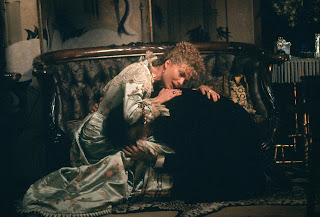February is the month of love, and while there are a million lightweight romantic comedies, there are only a few movies that address the real power and complexity of romantic love. There are fewer still that do so while simultaneously being well-acted, beautifully shot, and artfully constructed. One film that does all this and more is Martin Scorcese’s 1993 picture, The Age of Innocence.
Of course, Scorcese is most famous for his bloody, f-word packed epics about crime, greed, and insanity. You wouldn’t think that the maker of Taxi Driver, Goodfellas, The Departed, and The Wolf of Wall Street would be responsible for one of the most delicate and lovely literary adaptations in film – but he is.
The Age of Innocence
adapts Edith Wharton’s Pulitzer Prize winning 1920 novel of the same name. It
is the story of high society in old New York. Daniel Day Lewis plays Newland
Archer, a well-heeled young man from a good family engaged to marry the
girlish, naïve May Welland, played by 90s it-girl Winona Ryder. Newland is in
high society but not of it. Privately, he looks down on the repressive,
restrictive social culture and on the gossiping and vanity of his peers.
Nevertheless, he’s a good boy from a good family and so he gamely lives his
life in that world. But then May’s mysterious, exotic cousin Ellen returns to
town, fleeing a bad marriage to a European count. Ellen is played by 90s
it-woman, Michelle Pfeiffer.
Ellen, having spent most of her life in Europe, is almost completely out of touch with the unspoken rules and expectations that hang in the air at every dinner party and soiree. Though their relationship begins in innocence, Newland, who is charmed and fascinated by Ellen’s causal flouting of tradition, slowly falls in love with her. Being engaged to her cousin and living in a world where the slightest whisper of scandal can ruin a family forever makes this awkward to say the least.
When the film came out, few people saw it, and it actually
lost money. That’s a shame because it really is one of the most lovely,
lovingly constructed films I’ve ever seen. Every tool at a filmmaker’s disposal
is on glowing display. The opening credits alone are a marvel of color, sound,
and design. Joanne Woodward’s knowing, slightly weary narration sets the wise,
sad tone for the film. Everyone’s performance from Daniel Day Lewis’s
convincing mix of duty and desire to Richard E. Grant’s oily gossip-about-town
Larry Lefferts is exactly right. The production design and cinematography in
particular are marvelous. Each image is silky and saturated with rich color and
deep blacks, while the camera movement and editing are lively. Scorcese confidently
uses expressionistic lighting and devices like iris shots to get the maximum
amount of story and emotion out of each shot, but he never goes too far. For a
director known for excess, one of his greatest tricks in The Age of Innocence is how Scorcese conveys passion and power all
with tremendous restraint. It’s a perfect choice for a film about bridling
one’s passions.
Ultimately, the film is about love and the choices,
sacrifices, and compromises we make in its name. Even though Newland is in love
with Ellen, he marries May and stays with her out of a sense of duty and a
different kind of love. The film suggests
that sometimes life and relationships don’t turn out how you think they will
but also that sometimes they do turn out exactly how you planned but you find
it wasn’t what you really wanted. The film is heartbreaking and beautiful,
exhilarating, and complicated. A lot like love.











